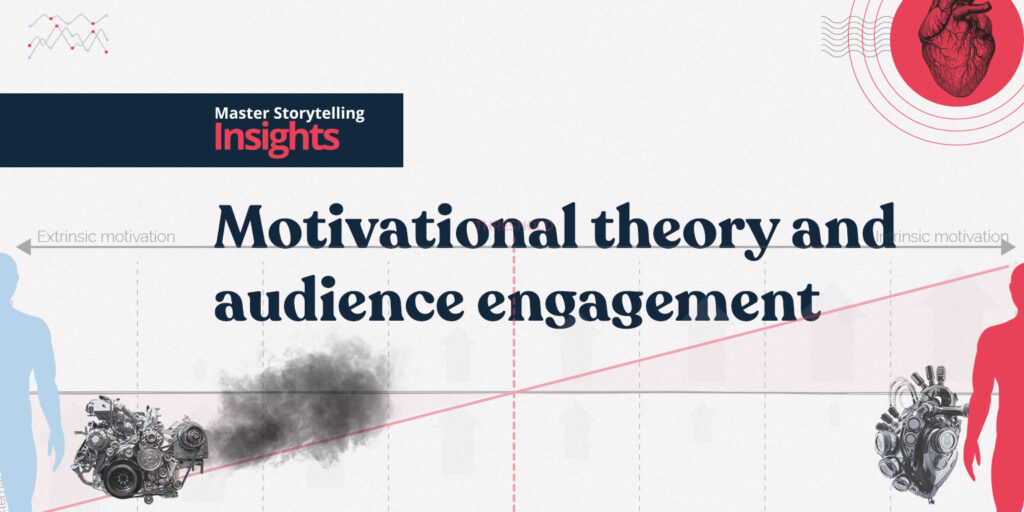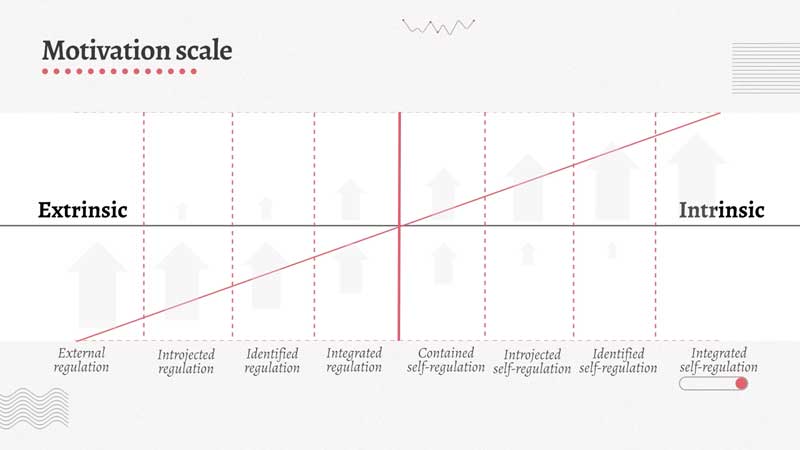Motivation matters. If we can’t get motivation right with our audiences, then no matter how much energy and resources we put into our work, the results will always be disappointing. Being able to work with and utilise the higher motivational types can yield incredible results.
There are broadly two different types of motivation, extrinsic and intrinsic and both have a different value system. One leads to short-term behaviours, the other to long-term behaviour change, one needs constant regulation, the other is self-regulating, one requires huge energy and processes to maintain it, the other is self-maintaining. This is the difference between extrinsic and intrinsic motivation respectively.
If we were to choose which motivation type we should be using with our audiences to bring about real and meaningful change, then it would seem to be a no-brainer. We should be using intrinsic motivational triggers to bring about positive change.
So, why is it that we keep gravitating towards extrinsic motivational triggers in all that we do, which feature on the lower end of the motivational continuum?
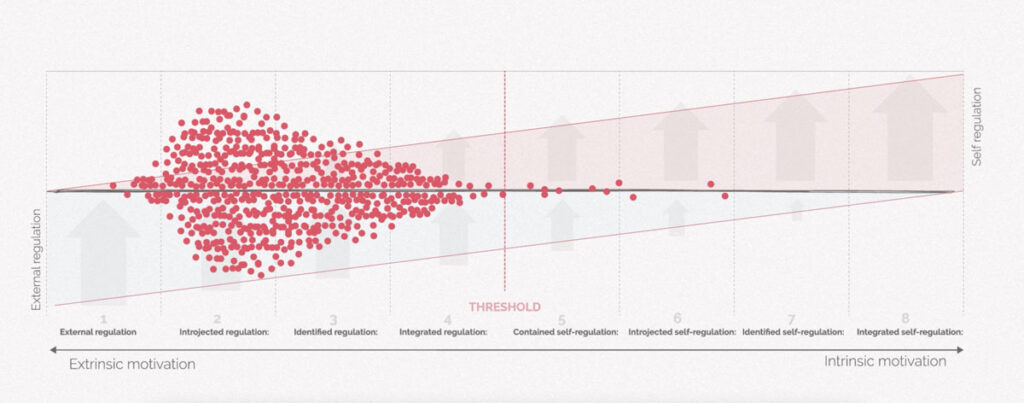
When we take a snapshot review of a range of marketing messages and campaigns from across the climate and environmental sector, we can see a clear trend in our marketing strategies. Most, if not all, of our messages lean towards the lower stages of the motivational continuum, towards extrinsic motivation, with very few – if any at all -sitting in the higher stages of the motivational stages.
The reasons behind this clear trend are complex and will take time to unpack and understand, but we can make the simple observation that we are clearly struggling with how to work with intrinsic motivational triggers. There is a whole knowledge base that we are lacking, the result of which has significant implications for our work as well as being able to bring about real change on the causes we care about.
The biggest challenge for climate campaigners and activists, it would seem, is not in raising awareness or explaining the need to take urgent action on the climate emergency. This has already been done to great effect. What we are collectively struggling on is how to create the motivation and political will for real change to happen. And how can we create the necessary long-term behaviour changes we need to see if we are to avoid the worst effects of climate change?
The answer all comes down to one thing: motivation.
If we want to create the necessary political will for real change, and for our audiences to be self-motivated and put their passion into action, then it would seem strange that we would collectively choose extrinsic motivational triggers to achieve these outcomes. It is worth noting, that it is not in the nature of extrinsic motivation to create long-term behaviour change, in fact, the nature of extrinsic motivation is to undermine long-term behaviour change.
Nor is it in the nature of extrinsic motivation to awaken the necessary values we need to bring about positive change, in fact, quite the opposite.
The problem with extrinsic motivation
So, why do we use extrinsic motivational triggers in everything that we do? The answer to that is simple: we use them because it’s easy and they work. In fact, it seems to make logical sense to use extrinsic motivational triggers in everything that we do, why would we ever consider using any other way to motivate our audiences into action?
But our use of extrinsic motivational triggers comes at a great cost.
If we take values theory seriously, where the very values we engage become the dominant values that shape our behaviours, then it would follow that engaging our audiences with motivational triggers that are based around greed, fear or ego, these values will always become the dominant values set, no matter the positive cause you were trying to engage your audience with.
In other words, creating eco-anxiety (fear) to drive positive environmental behaviours becomes counterproductive. It might seem to work in the short term but delivers terrible results in the long term. Only now are we beginning to understand the long-term effects eco-anxiety has on the mental health of young people and how this anxiety is creating psychological responses such as conflict avoidance, fear, helplessness, and resignation, all of which create serious barriers to creating the motivation to take action on the climate emergency.
Understanding what is behind this trend towards the lower end of our motivational continuum will require some unpicking. Here are just a few insights that can help us to understand why we are seeing this shift.
Outdated motivational models
The first challenge we have is around the outdated motivational models that dominate most of our thinking around audience engagement. If we use self-determination theory as an example, there is great detail and significant insights offered for extrinsic motivational stages.
But when it comes to intrinsic motivation, most models cluster this together as a single stage, with some very loose concepts of how intrinsic motivation works (i.e. fun, positive, love).
This model fails to grasp the interior dynamics that are necessary to create if we are to move our audiences up to the later stages of intrinsic motivation.


Our inability to fully understand and implement this motivation type into our work can have significant repercussions.
Kieran O'Brien - Director of Ministory Tweet
Lack of understanding of interiority
if we are to understand the nature of intrinsic motivation, we need to have a much better understanding of our interior selves, including a deeper understanding of our unconscious mind.
The temptation has been to view intrinsic motivation as a final stage in the motivation continuum, rather than trying to understand it as an entirely different eco-system, one that deploys a different ruleset when compared to extrinsic motivation.
As a result, our attempts at intrinsic motivation tend to look childish, filled with lots of love hearts, emotive, positive thinking and many other heart-based cliches.
Intrinsic motivation is driven by interior drivers. Understanding what these interior drivers are, how to work with them, and how to engage them in our work will require a different way of thinking. The same mindset that understands extrinsic motivation, is not the same mindset that understands intrinsic motivation.
To understand intrinsic motivation we need to approach this through a different paradigm.
Extrinsic motivation and the marketing paradigm
To understand the dominant trend towards using extrinsic motivation triggers in our work, we have to understand the context in which we find these trends. And that is within the marketing paradigm.
The nature of marketing is to create the need for someone to buy your product or service. Without creating a need or desire, then there is no sale. But to create the motivational trigger (especially for things that we don’t need), we have to play to the customer’s fear, greed or ego – in other words, their lower values.
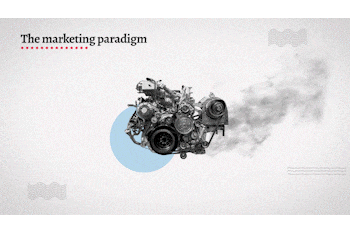
We can sum this up in a simple formula, first create the need, and then show how buying your product or service – or how your campaign or fundraiser – is the magical cure. Create anxiety and then show how you can take away that anxiety by joining a campaign, donating or any other action.
But, if we view the marketing paradigm as being driven by a motivational engine, then that engine is just like a fossil-fuelled engine. It works, but it works at a cost. Just like a fossil-fuelled engine, this engine is a pollutant. In order to create torque in the engine we need to create anxiety or play to your audience’s lower values in order to drive motivation. While this may make perfect sense in the short term, as it does work, we can begin to see that this approach actually undermines our ability to create the right psychological conditions that are needed to bring about positive change in our world.
When you create anxiety or use fear to drive your fundraiser or campaign, what happens to that anxiety afterwards? What happens if the audience doesn’t sign up or donate? Where does that anxiety go? Anxiety is a psychological pollutant, and using this pollutant in an attempt to drive positive change is a logical contradiction.
Intrinsic motivation is relational and requires a different way of thinking if we are to take our audiences to the higher stages of the motivational continuum. To do so, we need to change the way we think, to think less with a marketing mindset and more with a storytelling mindset.
Kieran O'Brien
Motivation and the unconscious mind
Understanding what the unconscious mind is and how it works is a huge issue that would take time to unpack and explain. For the sake of brevity, we know that extrinsic motivation is strongly correlated to the conscious mind, while intrinsic motivation is to the unconscious.
A better approach to this is to look at the two hemispheres of the brain and how they both work differently and how the dominant trend towards extrinsic motivational triggers can be seen as part of a much wider trend towards left hemisphere dominant thinking.
Building on the work of philosopher and neuropsychologist Iain McGilchrist, we can start to see how a shift in our disposition towards left-hemisphere dominant thinking clearly correlates to the wider trend towards extrinsic motivational patterns that we see today.
Read more on how to work with unconscious motivational triggers here.
Intrinsic motivation is substantively different in nature when compared to extrinsic motivation. It uses a different language, has different rules for engagement, it has a different value system, and it is driven by a different purpose dynamic. If we use the analogy of engines, if extrinsic motivation is a fossil-fuelled engine, then intrinsic motivation is an electric engine, powered internally by its own power source. Pouring fuel into this engine makes no sense, for its nature is fundamentally different.
If we are to work with this new ‘engine’ then we need to think differently and not try to apply the same logic behind the fossil-fuelled extrinsic engine.
This requires a shift from a marketing mindset to a storyteller mindset. Rather than thinking about how to get audiences to do something, which is the marketing mindset, instead this new mindset asks another question: How do we awaken the necessary values that we need to bring about the changes we seek?
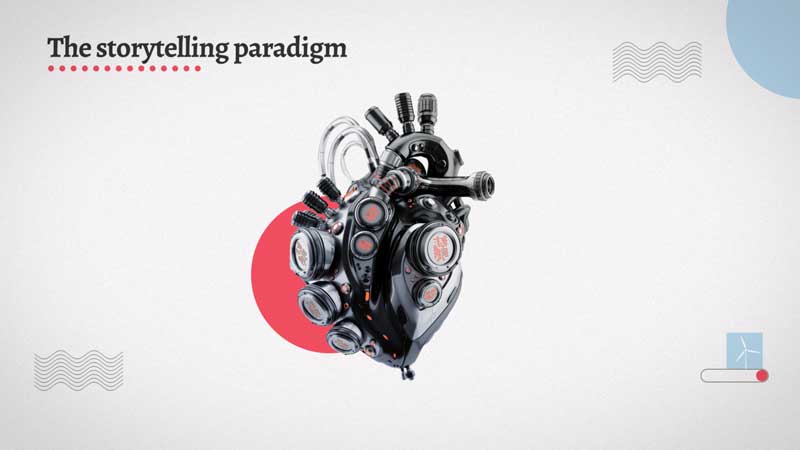
This shift in mindset creates a very different dynamic and motivational experience altogether. By adopting this new approach, we can start to think very differently about audience engagement, as well as creating new stories that don’t follow the same marketing pattern.
Rather than using stories to create an emotional experience, in order to drive the motivational tension for your audience to give or sign up for your campaign, we instead seek to use storytelling dynamics to help lead our audiences higher up the motivation continuum, creating the conditions in which real change can happen.
This requires a completely different skill set, one that understands how to work with the implicit nature of storytelling, including the metanarrative, and create the motivational triggers to help bring about real change. This skill set is called Master Storytelling, which is a powerful form of storytelling that can help to bring about real change on the issues we care about.
and approach to audience engagement and motivation, one which will mean unlearning some of the fundamentals of marketing logic , and developing a new set of skills and insights on how to use storytelling to help create the conditions to move your audiences up to the higher stages of the motivational continuum.
If we want to bring about real change happen on the causes that we care about, then we must be willing to make an intentional shift away from using extrinsic motivational triggers to drive audience engagement, which focuses on short-term responses, and learn how to work with intrinsic motivation, to create long-term behaviour change. To do this will require some retraining, where we move from the marketing paradigm (see Beyond the marketing paradigm) to the storytelling paradigm. Only then can we ever see this trend reversed.
Insights
- Across the wider sector, there is a clear trend towards using extrinsic motivational triggers in order to drive positive behaviour. This may work in the short term, but this approach will ultimately undermine your cause over the longer term. Using fear-based motivational triggers may create a transactional or immediate response, but is a poor motivator for long-term behaviour change.
- Our current motivation models are no longer fit for purpose. They over-emphasise the extrinsic stages and ignore the subtleties of the various intrinsic stages (see above). As a result, we have a very underdeveloped understanding of how intrinsic motivation works and how to engage with the later stages in the motivational continuum. The end result is that we remain trapped in the lower stages of motivation, struggling to create the necessary changes we seek for the causes we care about.
- Our inability to fully understand and implement intrinsic motivational triggers into our work can have significant repercussions. Our inability to work with intrinsic motivation can ultimately undermine the huge amount of energy and resources we pour into trying to create real political and societal change.
- Using extrinsic motivation to drive positive change can lead to burnout and exhaustion, especially for those on the front line of movements for positive change. The nature of extrinsic motivation is short-term and high-energy. Unless you have unlimited resources to support this motivation type, expect high costs, and high energy in order to create any real return.
- When we try to engage our audiences with intrinsic motivation and move towards love, we tend to create some very childish, over-simplistic campaigns that play to the inner child, rather than the inner adult. The result is that these campaigns and messages are not taken seriously, nor do they lead to real change.
- The clear trend towards using extrinsic motivational triggers across the sector is a result of the dominant paradigm that we use to engage our audiences. This is the marketing paradigm and its nature is to create fear or play to our lower values, in order to create tension to drive motivation. This paradigm is dominated by a values system which will ultimately undermine our work towards bringing about positive change.
- If we want to create real and positive change on the issues we care about, then we must look towards replacing the marketing paradigm motivational engine with a new one. This new motivational engine must have a bias towards higher values and work with intrinsic motivation. This engine is called the storytelling paradigm, adopting its use throughout our work can help to overcome some of the stubborn challenges we all face in regard to low motivation, overcoming polarisation, engaging cold and hard-to-reach audiences, as well as creating the political will for real change.
Solutions
To shift the trend on our motivational continuum to the right, where we are collectively working on the higher stages of the motivational continuum, we suggest the following:
- Apply the insights from the new motivational model above that gives equal weighting to intrinsic and extrinsic motivation, and not view intrinsic motivation as a fifth stage in the motivational continuum.
- Don't treat intrinsic motivation with the same mindset that we approach extrinsic. It is substantively different, and has a different set of values, rules and language. Learning what these are is essential if we are to create powerful intrinsic motivational triggers.
- Understand the relationship between marketing theory and extrinsic motivation, and how marketing approaches adopt extrinsic motivational triggers that can undermine your cause in the long term
- Explore the relationship between storytelling and intrinsic motivation, how certain storytelling methodologies can create the space for intrinsic values to emerge.
To take your learning further, explore our training programmes below or join one of our workshops. We recommend our full training programme Storytelling for a cause – the climate edition, which covers motivation theory and links this work to values theory, storytelling theory, the unconscious mind and how to build a storytelling engine that can be applied in your work.
Storytelling and motivation
Training programme-
Full lifetime access to 2hrs+ of online training
-
Full access to training materials and handouts
-
Unique approaches to motivational theory that can will have a significant impact in your work*
-
50% discount to a live workshop to explore your learnings (worth £75)
Our full online training course
New training programme.
Become a Master Storyteller with our specialist 13hrs+ online training course
Motivation theory
Explore a new approach to motivational theory and how to work with intrinsic motivational triggers
values theory
Insights into values theory and how to work with the flow of values and their relationship to each other
neuropsychology
Utilising insights on the different values systems of the two brain hemispheres and how to apply them
storytelling
Learn how to become a Master Storyteller, someone who can create powerful metanarratives
Storytelling training programmes.
These online, self-directed training courses are full of specialist insights, toolkits and methodologies that are designed to help you to create meaningful change in your work.
